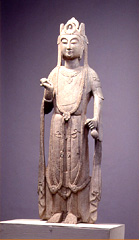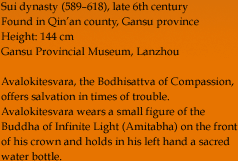 |
|
 |

My happiness is incomplete as long as there is a single unhappy being in the world. — Bodhisattva vow, Mahayana scriptures In Mahayana Buddhism, the concept of compassion is manifested in the image of the bodhisattva, or "enlightened being." The Sanskrit word "bodhisattva" denotes a human being who has attained enlightenment but has elected not to enter Nirvana, choosing instead to remain in the world to ensure the ultimate salvation of all sentient beings. Compassion is much more than sympathy and extends even to giving one's own life to save another. A bodhisattva actively helps others, sharing intuitive wisdom, understanding, and strength with all those who are seeking enlightenment. Aspects of Buddhahood are embodied in the most important bodhisattvas such as the Bodhisattva Avalokitesvara (compassion), the Bodhisattva Manjusri (wisdom), and Maitreya (the future Buddha). Although they are enlightened beings, bodhisattvas appear very different from Buddha. Buddhas are portrayed wearing plain monastic robes to denote their disavowal of earthly ties. Bodhisattvas are depicted as very human, with graceful bodies, full hips, and long hair; they wear crowns, skirts, scarves, and jewelry, and often hold lotus flowers, religious implements, or other symbolic objects. |
||||